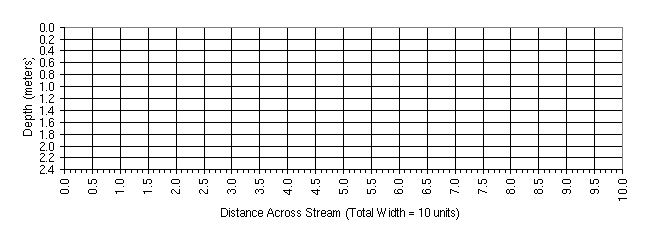
Geoscience 190 Environmental Geoscience
Return to course page | Return to Lab 5 page
Stream Discharge Lab
The amount of water that a stream carries is its discharge. Discharge is measured in units of volume per unit time (cubic meters per second, for example). Discharge depends upon the velocity of the stream and the stream's cross sectional area. The purpose of this lab is to estimate the discharge of a local stream. Depending on flow conditions, your lab section may measure the discharge of the Canandaigua Outlet, or Kashong Creek.
Materials and Preparation
Before coming to lab you should have read pages 279-297 in Chapter 13 of Press and Siever and have a good grasp of stream discharge versus velocity and how drainage basins are defined. Also read through this handout carefully.
Bring pens or pencils and a calculator to lab with you. This is a field lab so dress for the weather. We will be working in the water and mud along the stream bank so wear old clothes and shoes that you do not mind getting muddy. The actual measurements will be done in groups; one person in each group will be outfitted with a pair of hip boots to wade across the stream in. If others want to get in the stream they should wear old shorts and sneakers. Barefoot wading is dangerous; the bottom has broken glass and fish hooks mixed in with the mud!
Methods
The theory behind the measurement of discharge is simple. We imagine that the stream is divided up into sections as illustrated in Figure 1. For each section we approximate its cross sectional area as a rectangle of height equal to the stream depth in the center of the section, and of width equal to the width of the section. If this area is multiplied by the stream's velocity, the result is the discharge, the volume of water that moves through that cross sectional area in unit time:
Area (m2) * Velocity (m/sec) = Discharge (m3/sec)
This is the discharge for one particular section. Because adjacent sections will have different depths and velocities, each section is likely to have its own discharge. The discharge of the entire stream is the sum of the discharges for each section. The measurements of stream width and depth can be done directly using a tape measure and graduated staff. To measure the stream's velocity we will use a stopwatch to time the number of seconds a neutral buoyancy float requires to travel one meter downstream. The reciprocal of this travel time is the velocity in meters per second.
Procedure
We will begin by thinking about how much discharge we should expect the stream we are going to measure to carry. To help us in this work, we will look at some historical discharge data and make an informed guess at the discharge we will measure. That accomplished, we will break into small groups of 3-4 persons, go out into the field and make our measurements. Each group will hand in a single discharge measurement.

Figure 1.
Heading off to the Field .....
Before leaving the lab each group should check to make sure that they have the following items:
- 30 m tape measure
- stopwatch
- graduated wading staff
- float
- Stream Discharge Worksheet
- Calculator
- Pen or Pencil
Upon arriving at the stream, each group will be given a specific location along the stream to make their discharge measurements. To measure the discharge, each group first measures the width of the stream using the tape measure. This width is used to calculate the positions of ten equally spaced measurement stations across the stream's width. Once the positions of these stations are known, measurements of depth and velocity can begin. At each of the ten stations the stream depth is measured using a graduated staff. Velocity is calculated from the time required for a neutral buoyancy float to travel one meter downstream.
After measuring the depth and velocity, the group should plot heir stream depths on the worksheet to make a cross sectional profile of the stream. Finally, each group should use the worksheet to calculate the discharge.
Assignment
Each person must write a brief lab report which describes the location and character of the stream, presents the results of your group's discharge measurement, and discusses those results. The report must refer directly to the plots and table of discharge measurements as numbered Figures and Tables.
Your report is due at the beginning of next week's lab period. It must be typed, double spaced, nd will be graded on content, clarity and grammar.
Revised 9/01 DBM
Stream Discharge Worksheet
Step
1: Calculate/Measure the following:
Total width of the stream,
w = ___________________ meters.
Width of each subdivision, D w = w / 10 = __________________ meters.
Step 2: Fill in the data worksheet below. Location = Mid-Point Location Factor x D w
|
Station i |
Mid-Point Location Factor |
Location m |
Depth di, m |
Time ti, sec |
Velocity Vi, m/s = 1/ti |
Discharge Qi, m3/s = D w di Vi |
|
1 |
0.5 |
|
|
|
|
|
|
2 |
1.5 |
|
|
|
|
|
|
3 |
2.5 |
|
|
|
|
|
|
4 |
3.5 |
|
|
|
|
|
|
5 |
4.5 |
|
|
|
|
|
|
6 |
5.5 |
|
|
|
|
|
|
7 |
6.5 |
|
|
|
|
|
|
8 |
7.5 |
|
|
|
|
|
|
9 |
8.5 |
|
|
|
|
|
|
10 |
9.5 |
|
|
|
|
|
After filling out the entire table above then calculate the total stream discharge:
Total
Q = S
Qi = __________________ meters3/second
Stream Profile: Water depth versus distance across stream.
